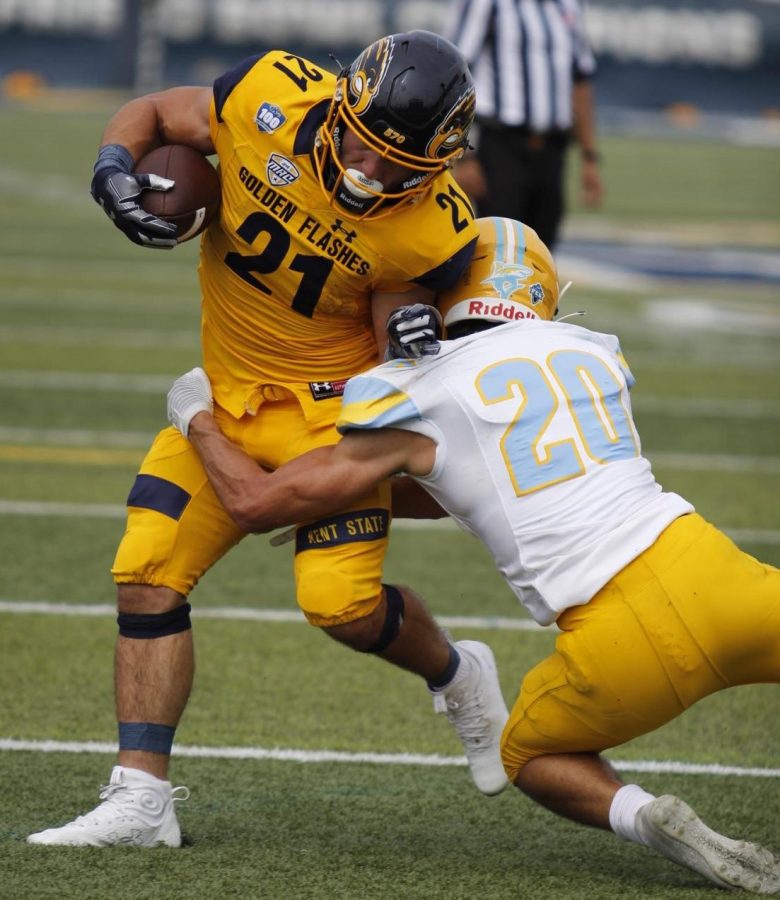Athletic department, football program earn big bucks from tough non-conference matchups
Kent State running back Gavin Garcia, who is now a sophomore on the team, breaks a tackle during his run downfield Sept. 17, 2022 against Long Island. Kent State won the match 63-10.
November 18, 2022
Kent State will be paid $5.2 million by January 2023 for playing – and losing to – three football teams from the Power 5 conferences: No. 1-ranked Georgia, then-No. 7 Oklahoma and the Pac-12’s Washington.
That total is nearly 21% of the athletic department’s $25 million budget.
“It’s like a sacrificial lamb,” said Laing Kennedy, the university’s athletic director from 1994-2010. “We need to find some way to generate significant dollars for our budget. The problem facing the athletic director and the athletic administration is we’re not a big-money program.”
Kent State began this season against four non-conference teams.
The university made $1.8 million from its 45-20 loss at Washington, $1.5 million from its 33-3 loss at Oklahoma and $1.9 million from its 39-22 loss at Georgia.
“My immediate reaction was that it was too tough,” Kennedy said. “But we played pretty well. We held our own. We had no really serious injuries. So you figure, ‘We got through that, we made some money. Now let’s go win some games.’”
KSU entered the Mid-American Conference at 3-1, with its only win coming in the third game of the season against non-FBS Long Island.
Four of the six teams in the MAC East played and lost to at least one ranked non-conference team. Akron lost to then-No. 2 Tennessee and then-No. 23 Liberty and earned $2.75 million total from its four non-conference games this season.
Georgia, which ranks No. 1 in the NCAA, played three non-conference teams this season, two were non-Power 5 opponents.
No. 2 Ohio State played three non-Power 5 teams — including Toledo, which is tied for first in the MAC.
Who gets the money
The $5.2 million goes directly to Kent State’s athletic department, which allocates the money where it sees fit.
With fifth-year football coach Sean Lewis’ contract renewal in August 2021, the football budget is guaranteed top funding from the competition.
Lewis’ contract, which extends through the 2025 season, states $50,000 will be allocated to the football budget if two non-conference games generate at least $1 million.

The football budget will get $100,000 for a third non-conference game which guarantees KSU at least $1 million. This continues until the renewed contract ends.
This season, the football budget earns the full $200,000 from its three Power 5 games. Kent State did not earn money from playing Long Island, its fourth non-conference opponent.
Lewis said he “has tremendous input now” on future scheduling with current AD Randale Richmond, who was hired in May 2021.
This season’s lineup was assembled by Joel Nielsen, his predecessor. Schedules are made up to five years in advance.
“We’re looking to put our kids in the best spot and our department in the best position to be successful,” Lewis said.
A little non-conference history
Kennedy became Kent State’s AD in 1994 after serving as Cornell’s athletic director for eleven years. He graduated from Cornell in 1963 as an ice-hockey student athlete.
From 1994-1997, the football team played two non-conference teams a season. Previously, the Flashes only faced a ranked non-conference team in 1977, 1987, 1989 and 1990.
In 1998, the team played Georgia, its first nationally-ranked challenge under Kennedy. The Flashes faced a ranked opponent in seven of the next 12 seasons.
Four non-conference teams entered the schedule for the first time in 2008.

Contract negotiations to set up the games and payments are handled directly by each university’s athletic director. Kennedy said he tried to adhere to a scheduling philosophy.
“I always wanted to start the football season at home against a winnable opponent,” he said. “That worked pretty well. With number two, it was a 50-50 game on the road. We had a great relationship with the armed services. Those weren’t necessarily big-money games – we might’ve given Navy $20,000 to come here, and they gave us $20,000 to go there.”
Kent State played Army or Navy during six seasons under Kennedy.
“Then, we would have a major contract game, primarily for money,” he said. “We had great success scheduling Ohio State when Jim Tressel was head coach. It was a hot ticket.”
For the majority of the following years, Kent State started the season against four non-conference opponents.
“As athletic director, you want to win the game and bring home a big check,” Kennedy said. “That was our dream.”
Kennedy’s most memorable big-money-game win came in 2007’s season opener at Iowa State, when the Flashes beat the Big-12 team 23-14.
By 2010, Joel Nielsen was athletic director.

Under Nielsen, who was hired in 2010, Kent State lost to then-No.1 Alabama 48-0 in 2016 and played two nationally-ranked teams in 2017.
In 2021, Randale Richmond’s first football season as AD, the Flashes played two ranked programs.
Before deciding a schedule – seasons in advance – Kennedy would ask coaches what teams they wanted to play for millions of dollars.
“I always felt they really enjoyed it, maybe not quite as much as the players,” Kennedy said. “It seemed like they thought, ‘You know what, that would be a great exposure for our program. We’re going to be on TV. We’ll be one of the Big 10’s featured games that day. That is something that would be of value to us.’”
Players had a similar reaction.
“I would ask them, ‘do you really like doing this?’” Kennedy said, “and for the most part, they said, ‘We love that game. It’s an experience of playing big time.’”
When major programs – like Ohio State, which has one of the nation’s largest athletic budgets at over $215 million – face challenges, Kennedy said those departments can fix their problems with money. Kent State can’t.
“We cannot make mistakes that cost us money,” he said. “We have to have a comprehensive program where we’re good in every sport that we play. We must fund our programs and follow the Title IX regulations – and we take that part of our business very seriously. In order to make that all happen, we have to do something to raise millions of dollars.”
Next year: $3.6 million
The Flashes open next season at current-No. 25 University of Central Florida. They then play at Arkansas, at home against non-FBS Wagner and then at Fresno State. UCF and Arkansas are Power 5 programs.
Kent State is 2-2 with UCF and has never played the other three opponents.
Kent State will receive $3.6 million from the three away non-conference games– $900,000 from UCF, $1.6 million from Arkansas and $1.1 million from Fresno State.
“For the most part, coaches, like the players, look at it as a challenge and an opportunity of a lifetime to experience that kind of trip,” Kennedy said. “But at the same time, you have to say to yourself, ‘We’re not going to win that game. Why are we doing it?’ We’re doing it for the money, and in a way that doesn’t feel right – but that’s why we do it.”
Isabella Schreck is sports editor. Contact her at [email protected].












